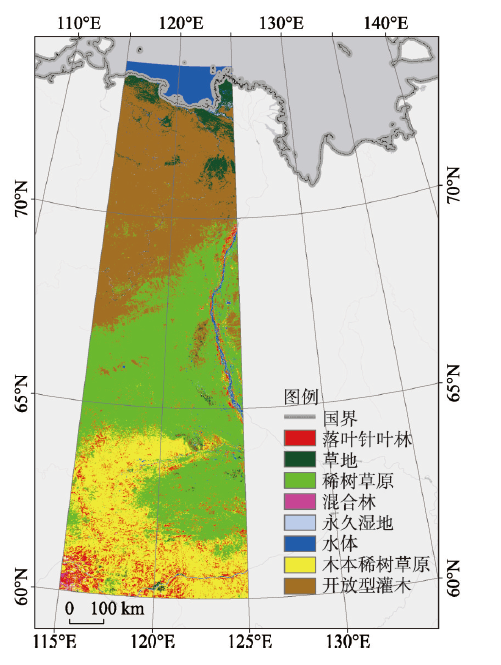

东西伯利亚苔原—泰加林过渡带植被遥感物候时空特征及其对气温变化的响应
|
李程(1991-), 男, 山东沾化人, 博士生, 主要从事植被物候变化遥感监测方面的研究。E-mail: licheng@lreis.ac.cn |
收稿日期: 2020-05-07
要求修回日期: 2021-04-27
网络出版日期: 2021-09-25
基金资助
高分辨率对地观测系统国家重大科技专项项目(30-Y20A07-9003-17/18)
版权
Spatiotemporal variations in remote sensing phenology of vegetation and its responses to temperature change of boreal forest in tundra-taiga transitional zone in the Eastern Siberia
Received date: 2020-05-07
Request revised date: 2021-04-27
Online published: 2021-09-25
Supported by
Major Projects of High Resolution Earth Observation(30-Y20A07-9003-17/18)
Copyright
物候变化是气候变化的重要指示器,通过对植被物候时空变化的研究可以为进一步分析全球气候变化提供依据。基于2000—2017年MODIS-NDVI时间序列数据,利用不对称高斯函数和动态阈值法,提取、分析了东西伯利亚苔原—泰加林过渡带植被生长季起始期(SOS)、结束期(EOS)、中期(MOS)和长度(LOS)4种植被遥感物候参数的时空变化格局。同时结合同期CRU(Climate Research Unit)气温观测数据,分析了4种物候参数对气温变化的响应关系。结果表明:遥感物候参数可以直接、有效地反映气温的变化:研究区64°N以南区域4—5月气温升高,对应区域SOS提前5~15 d;64°N~72°N之间5—6月气温升高,对应区域SOS提前10~25 d;最北端北冰洋沿岸6月气温升高幅度较小且7月气温降低,对应区域SOS推后15~25 d;西北部8月、西南部9月气温降低,对应地区EOS提前15~30 d;67°N以南区域9—10月气温升高,对应区域EOS推后5~30 d;EOS的变化对气温变化较SOS更为敏感,较小的气温波动即引起EOS较大的变动;研究区内植被生长季整体呈前移趋势,且西北部LOS缩短,中部、南部LOS延长。

关键词: 遥感物候; 气候变化; 西伯利亚; 不对称高斯函数; MODIS-NDVI
李程 , 庄大方 , 何剑锋 , 文可戈 . 东西伯利亚苔原—泰加林过渡带植被遥感物候时空特征及其对气温变化的响应[J]. 地理学报, 2021 , 76(7) : 1634 -1648 . DOI: 10.11821/dlxb202107005
Phenology is an important indicator of climate change. Studying spatiotemporal variations in remote sensing phenology of vegetation can provide a basis for further analysis of global climate change. Based on time series data of MODIS-NDVI from 2000 to 2017, we extracted and analyzed four remote sensing phenological parameters of vegetation, including the Start of Season (SOS), the End of Season (EOS), the Middle of Season (MOS) and the Length of Season (LOS), in tundra-taiga transitional zone in the East Siberia, using asymmetric Gaussian function and dynamic threshold methods. Meanwhile, we analyzed the responses of the four phenological parameters to the temperature change based on the temperature change data from Climate Research Unit (CRU). The results show that: in regions south of 64°N, with the rise of temperature in April and May, the SOS in the corresponding area was 5-15 days ahead of schedule; in the area between 64°N and 72°N, with the rise of temperature in May and June, the SOS in the corresponding area was 10-25 days ahead of schedule; in the northernmost of the study area on the coast of the Arctic Ocean, with the drop of temperature in May and June, the SOS in the corresponding area was 15-25 days behind schedule; in the northwest of the study area in August and the southwest in September, with the drop of temperature, the EOS in the corresponding areas was 15-30 days ahead of schedule; in regions south of 67°N, with the rise of temperature in September and October, the EOS in the corresponding area was 5-30 days behind schedule; the change of the EOS in autumn was more sensitive to the change of the SOS in spring, because the smaller temperature fluctuation can cause the larger change of the EOS; the growth season of vegetation in the study area was generally moving forward, and the LOS in the northwest was shortened, while the LOS in the middle and south of the study area was prolonged.

表1 植被生长季遥感物候参数定义Tab. 1 Definition of vegetation growth season parameters extracted from NDVI data |
| 植被生长季参数 | 参数定义 |
|---|---|
| 生长季起始期(SOS) | 在NDVI生长曲线的左侧,当NDVI值从最小值上升到年际NDVI振幅的10%时所对应的天数 |
| 生长季结束期(EOS) | 在NDVI生长曲线的右侧,当NDVI值从最大值下降到年际NDVI振幅的10%时所对应的天数 |
| 生长季中期(MOS) | 曲线左侧NDVI上升到年际振幅80%时对应的天数到曲线右侧NDVI下降到年际振幅80%时对应的天数,之间天数的中点 |
| 生长季长度(LOS) | 从生长季起始期到生长季结束期之间的天数 |
感谢中国科学院资源环境科学数据中心刘荣高研究员、徐新良研究员和刘洋副研究员为本文提供数据支持,感谢本文匿名审稿专家为本文的完善提出的宝贵意见。
| [1] |
[ 竺可桢, 宛敏渭. 物候学. 北京: 科学出版社, 1975: 1-4.]
|
| [2] |
|
| [3] |
|
| [4] |
[ 李晓婷, 郭伟, 倪向南, 等. 高寒草甸植物物候对温度变化的响应. 生态学报, 2019,39(18):6670-6680.]
|
| [5] |
[ 刘玉洁, 陈巧敏, 葛全胜, 等. 气候变化背景下1981—2010中国小麦物候变化时空分异. 中国科学: 地球科学, 2018,48(7):888-898.]
|
| [6] |
[ 徐雨晴, 陆佩玲, 于强. 近50年北京树木物候对气候变化的响应. 地理研究, 2005,24(3):412-420.]
|
| [7] |
[ 戴君虎, 王焕炯, 葛全胜. 近50年中国温带季风区植物花期春季霜冻风险变化. 地理学报, 2013,68(5):593-601.]
|
| [8] |
[ 张晓东, 朱文博, 张静静, 等. 伏牛山地森林植被物候及其对气候变化的响应. 地理学报, 2018,73(1):41-53.]
|
| [9] |
[ 俎佳星, 杨健. 东北地区植被物候时序变化. 生态学报, 2016,36(7):2015-2023.]
|
| [10] |
[ 茹皮亚·西拉尔, 杨辽. 新疆棉花物候时空变化遥感监测及气温影响分析. 遥感技术与应用, 2018,33(5):923-931.]
|
| [11] |
[ 马晓芳, 陈思宇, 邓婕, 等. 青藏高原植被物候监测及其对气候变化的响应. 草业学报, 2016,25(1):13-21.]
|
| [12] |
[ 宛敏渭, 刘秀珍. 中国物候观测方法. 北京: 科学出版社, 1979.]
|
| [13] |
[ 夏传福, 李静, 柳钦火. 植被物候遥感监测研究进展. 遥感学报, 2013,17(1):1-16.]
|
| [14] |
[ 曾玲琳. 作物物候期遥感监测研究: 以玉米与大豆为例[D]. 武汉: 武汉大学, 2015.]
|
| [15] |
|
| [16] |
[ 李兰晖, 刘林山, 张镱锂, 等. 青藏高原高寒草地物候沿海拔梯度变化的差异分析. 地理研究, 2017,36(1):26-36.]
|
| [17] |
|
| [18] |
[ 陈效逑, 王林海. 遥感物候学研究进展. 地理科学进展, 2009,28(1):33-40.]
|
| [19] |
|
| [20] |
|
| [21] |
[ 郭剑, 陈实, 徐斌, 等. 基于SPOT-VGT数据的锡林郭勒盟草原返青期遥感监测. 地理研究, 2017,36(1):37-48.]
|
| [22] |
[ 张学霞, 葛全胜, 郑景云. 遥感技术在植物物候研究中的应用综述. 地球科学进展, 2003,18(4):534-544.]
|
| [23] |
[ 吴文斌, 杨鹏, 唐华俊, 等. 基于NDVI数据的华北地区耕地物候空间格局. 中国农业科学, 2009,42(2):552-560.]
|
| [24] |
[ 刘玉洁, 葛全胜, 戴君虎. 全球变化下作物物候研究进展. 地理学报, 2020,75(1):14-24.]
|
| [25] |
|
| [26] |
|
| [27] |
|
| [28] |
|
| [29] |
|
| [30] |
[ 于信芳, 庄大方. 基于MODIS NDVI数据的东北森林物候期监测. 资源科学, 2006,28(4):111-117.]
|
| [31] |
|
| [32] |
|
| [33] |
|
| [34] |
|
| [35] |
|
| [36] |
|
| [37] |
[ 文可戈. 北方高纬度地区植被的气候变化响应研究(2000—2013年)[D]. 北京: 中国科学院大学, 2016.]
|
| [38] |
|
/
| 〈 |
|
〉 |